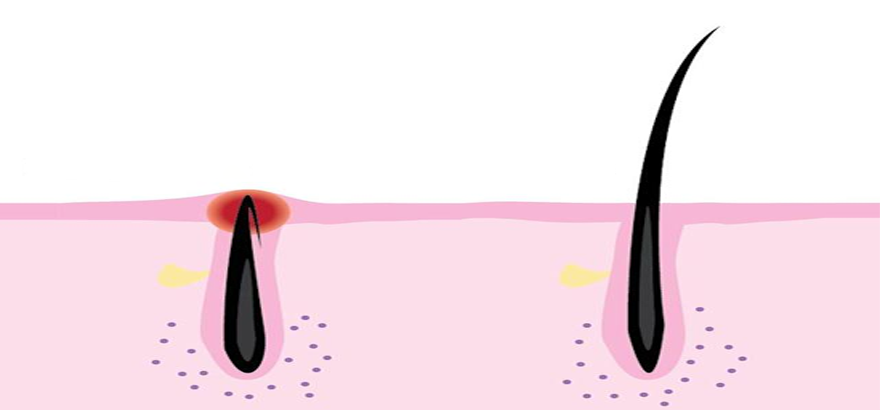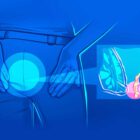Ingrown hair occurs when a hair that’s been removed starts to grow back and curves into the skin. Shaving, tweezing or waxing can cause this to happen. An ingrown hair can cause tiny, swollen bumps on the skin that may hurt. The condition most often affects Black people with curly hair who shave.
Most instances of ingrown hair get better without treatment. You can avoid this condition by not removing hair or not shaving very close to the skin. If that’s not an option, you might try other hair removal methods that lessen the risk of developing ingrown hair.
How to Identify and Treat an Ingrown Hair Cyst
A cyst is a large bump that extends from the skin’s surface and deep underneath it.
In some instances, an ingrown hair can cause a cyst, resulting in an ingrown hair cyst. Other types of bumps, such as pseudofolliculitis barbae and pimples, may also be mistaken for ingrown hair cysts.
Keep reading to learn what causes these skin conditions to form, plus how to treat them and prevent them from returning.
How do you identify an ingrown hair cyst?
As the name suggests, ingrown hair cysts start off as ingrown hairs.
At first, you might notice a small pimple-like bump with a hair at its surface. It may also be red in color.
Over time — if the ingrown hair doesn’t go away — the small bump can transform into a much larger one. The resulting bump can be red, white, or yellow. It may also be painful to the touch.
Identifying pseudofolliculitis barbae
Although it’s possible for cysts to develop near ingrown hairs, most bumps that form near ingrown hairs are likely to be caused by pseudofolliculitis barbae, also known as razor bumps.
Razor bumps can occur anywhere on your body, but they’re more likely to develop in areas that are prone to ingrown hairs, including your:
- armpits
- face
- head
- neck
- legs
- pubic region
Identifying cystic acne
Ingrown hair cysts and razor bumps may also resemble cystic acne.
While an infected ingrown hair cyst starts off as a regular ingrown hair, acne cysts are caused by a combination of bacteria, oil, and dead skin cells that accumulate deep under the hair follicle.
Cystic acne can be widespread in one area, such as your back or face. Ingrown hair cysts, on the other hand, are smaller in number and contained — you may just have one.
What causes these bumps to form?
Improper hair removal techniques may lead to these bumps.
Whether you shave, wax, or tweeze, removing hair isn’t always trouble-free. The process itself can cause swelling, which may irritate your skin and lead to razor bumps and cysts.
Removing a hair can also cause the new hair that grows in its place to grow in incorrectly. The new hair may grow sideways and eventually curl back down.
When this happens, the hair follicle can close over the hair so it becomes stuck, or ingrown. The skin responds by becoming inflamed, treating the curled-back hair as a foreign object.
Razor bumps are most common in Black men and people who shave.
You may also be at greater risk for developing bumps with ingrown hairs if you have naturally curly hair.
What treatment options are available?
The primary goal of treatment is to reduce surrounding inflammation and decrease your risk for infection.
Possible treatments for razor bumps include keeping the skin moisturized and discontinuing shaving, which allows the ingrown hairs to grow out.
Over-the-counter (OTC) medications containing benzoyl peroxide or retinoids can reduce inflammation and decrease the size of razor bumps or ingrown hair cysts.
Prescription acne medications might be needed if OTC methods don’t work for razor bumps or ingrown hair cysts.
The ultimate goal of treatment for any ingrown hairs is to reduce their occurrence by keeping the skin exfoliated and moisturized. Body washes and lotions made with gentle glycolic acid will help.
However, once an ingrown hair cyst has become inflamed and starts to fluctuate in size, incision and drainage may be required to shrink the cyst and remove the ingrown hair.
What not to do
Never pop an ingrown hair cyst, as this can increase your risk for infection and scarring.
You also shouldn’t try to lift the hair out with tweezers like you might with a normal ingrown hair. At this point, the hair is embedded far too deep underneath the bump or cyst for you to pull it out.
Instead, you should encourage the bumps and cysts to go down and the hair to straighten upward by gently scrubbing them with a warm cloth a couple of times a day.
Treating an infection
If you develop an infection, a healthcare professional will prescribe either topical or oral antibiotics. Antibiotics will help reduce inflammation and pain while also preventing the infection from spreading and getting worse.
When should you see a healthcare professional?
In most cases, you won’t need to see a healthcare professional for these types of bumps and cysts. OTC treatments can usually help coax the hair out.
If the bumps or cysts become extremely bothersome — or if they aren’t fading — see a healthcare professional or dermatologist.
They can drain the cyst and remove the ingrown hair. You can book an appointment with a dermatologist in your area using our Healthline FindCare tool.
You should also see a healthcare professional if you suspect an infection. Signs of infection include:
- pus oozing from the bump or cyst
- increased redness
- itchiness
- increased pain
- foul odor
- swelling
- fever
Can you prevent an ingrown hair cyst?
The only way you can prevent ingrown hairs from occurring at all is to refrain from hair removal altogether.
Hair removal methods that don’t require shaving are less likely to result in ingrown hairs, but they don’t necessarily get rid of the problem entirely. If you’re prone to getting ingrown hairs, you may still be at mild risk even with some of these methods.
The best way to reduce the incidence of ingrown hairs is to stop tweezing, plucking, and waxing the hairs until the ingrown hair has made its way out by itself or with the help of a professional.
If you do decide to remove the hair yourself, practice smart hair removal to reduce your chance of ingrown hairs.





